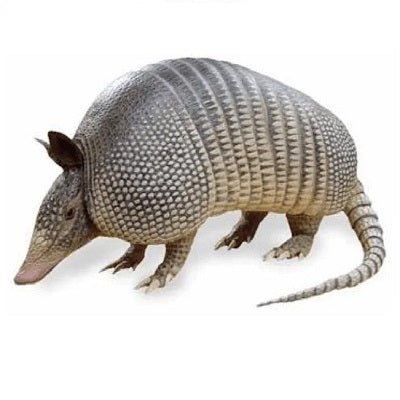
Color: pink and dark brown to black, gray, yellow and red.
Size: The smallest is the pink fairy armadillo, which is about 6 inches (15 centimeters) long.
Giant armadillos are the largest species, and are about 5 feet (1.5 meters) long.
Armadillos live in temperate and warm habitats, including rain forests, grasslands, and semi-deserts.
Activity: In native southern regions, armadillos are nocturnal year-round, keeping cool underground during the day and foraging at night. However because of the armadillos' relatively low body temperature, the nine-banded species in North America tends to change its habits in the cooler months and emerge during the day to take advantage of the warm sun.
Reproduction: Reproduction for the nine-banded armadillo begins in early summer, and the breeding period lasts about 2-3 months. It takes up to 4 months for a fertilized egg to become implanted and another 4 before young are born. Each time, the fertilized egg breaks into four identical zygotes, yielding quadruplets.
Social Interaction: Solitary animals, armadillos spend their lives foraging alone and only interact to breed or care for their young. Young armadillos become independent about 6-12 months after they are born.
Digging: Armadillos are prolific diggers that excavate land for food and dig profound burrows for shelter. They prefer to dig in areas with loose, porous soil, rich in insects and invertebrates.
Armadillos are mainly insectivores, with over 90% of their diet consisting of animal matter, like insects and other invertebrates like beetles, larvae, worms, termites, grasshoppers, ants, maggots, snails etc..
Most armadillo damage comes about as a result of their digging habits, taking the forms of holes and burrows.
Armadillos have the ability to carry the bacterium that causes leprosy in humans (Mycobacterium leprae).
Reduce Attractants
Armadillos wander into your yard in search of food and shelter. Because the majority of an armadillo's food is underground, completely removing attractants is nearly impossible. However there are important steps you can take to make your yard less welcoming:
Remove cover like brush, woodpiles, low-lying bushes and shrubs. Armadillos prefer to burrow in areas with ample cover, so by opening up your yard, they'll feel less at home.
Clean up any fallen berries or fruit, which may attract armadillos.
Fencing:
Use a properly constructed fence to completely exclude armadillos from your yard or garden. Your armadillo fence should achieve the following in order to keep armadillos out:
- Stand at least 24" tall
- penetrate the ground at least 6-12"
- angle outwards at the top, about 40°
Fencing may be intrusive to the aesthetic of your backyard, but it's effective and one of the best ways to keep your yard clear of armadillo destruction.
Manufacturer Recommended Products And Treatment For Armadillo Control
Pests need food, water, and shelter. Often the problem may be solved just by removing these key items. Before even thinking about chemical pest control, it is important to be aware of
| Conducive Condition | Recommendation | |
| 1 | Tree branches on house | Keep tree branches away from house to reduce pest access |
| 2 | Firewood next to foundation | Keep firewood away from house to reduce pest harborage |
| 3 | Debris on crawlspace/next to foundation | Remove wood debris to reduce termite ha rborage area |
| 4 | Excessive plant cover, stump, etc. | Providing spacing between plant cover and structure |
| 5 | Soil above the foundation Ii ne | Keep soil below top of foundation to reduce harbo rage areas |
| 6 | Wood-to-ground contact | Keep soil from touching wood to eliminate termite access |
| 7 | Debris on roof/full gutter | Keep gutter & roof free of debris to reduce insect harborage |
| 8 | Standi ng water near/under structure | Eli minate standing water to reduce pest harbo rage |
| 9 | Mo isture problem under structure | Increase ventilation to reduce pest harbo rage area |
| 10 | Openi ngs at plumbi ng & electronics | Seal opening to reduce pest access |
| 11 | Excessive gaps at windows/doors | Seal gaps to reduce pest access |
| 12 | Lea ky plumb ing fixtures | Repair to reduce moisture for pests |
| 13 | Keep garbage cans covered | Covered to reduce attraction of insects of vertebrate pests |
| 14 | Mo isture damage wood | Repair rotten or damaged wood to reduce insect harborage |
| 15 | Grocery bags stored improperly | Seal paper sacks in containers to reduce i nsect ha rborage areas |
| 16 | Pet food unsealed or left out | Keep pet food in sealed containers and unavailable to pests |
| 17 | Excessive storage conditions | Keep storage areas uncluttered and manageable |
| 18 | Debris below kick plates | Remove kick plates to reduce rodent harborage |
Product Type
1 product


